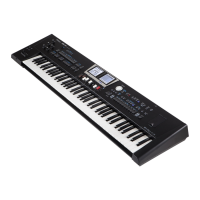44
12. Using the BK-9 as a USB player
This section explains how to playback MIDI (SMF) and audio songs
stored on an optional USB memory. Note that it is also possible to
select rhythms on that device and to use them in the same way as
the internal rhythms. New song and rhythm les can be copied to
the USB memory using your computer as you purchase them.
Getting Ready to Use the BK-9 as a
USB Player
1. On your computer, copy the new song and rhythm les to
an optional USB memory (memory stick).
NOTE
Use USB memory sold by Roland (M-UF-series). We cannot
guarantee operation if any other USB memory is used.
2. Connect the USB memory to your BK-9.
NOTE
Carefully insert the optional USB memory all
the way into the port until it is rmly in place.
NOTE
Never remove a USB memory while this unit
is turned on. Doing so may corrupt the unit’s
data or the data on the USB memory.
NOTE
The BK-9 supports USB memories with a capacity of up to 2 TB.
File types the BK-9 can read and play back
Extension Format
Rhythms .stl
Standard MIDI Files
(SMF)
.mid 0 or 1
.kar
Audio les
.mp3
• MPEG-1 Audio Layer 3
• Sampling frequency: 44.1kHz
• Bit rate: 32/40/48/56/64/80/96/112/
128/160/192/224/256/320 kbps,
VBR (variable bit rate)
.wav, .aif
• 16-bit linear
• Sampling frequency: 44.1 kHz
• Stereo/mono
NOTE
The BK-9 is not able to read audio les with “.AIFF” extension.
Please use your personal computer to rename the le extension
to “.AIF”.
Caution when Playing Back Audio Files
Playing back an mp3 le or changing the playback tempo of an
audio le places a signicant processing burden on the BK-9, and in
some cases may cause it to be unable to completely process all of the
performance data from the keyboard.
If this occurs, you may be able to solve the problem by taking the
following actions.
• Use WAVE/AIFF format data rather than mp3 format data
• Return the song tempo to its original setting (to 0%)
An mp3 le has little time of the blank at the head and the end of
the le. Therefore, the sound might cut o when an mp3 le played
repeatedly with Audio Key function.
If this occurs, you may be able to solve the problem by taking the
following actions.
• Use WAVE/AIFF format data rather than mp3 format data
Selecting a Song or Rhythm on a USB
Memory
1. Connect an optional USB memory to the BK-9 or, if it was
already inserted, press the [USB MEMORY] button
After a few seconds, the display shows the contents of the USB
memory.
Right Display
The icons to the left of the le names indicate the le type:
Icon Explanation
Rhythm le
SMF le
Audio mp3 le or .KAR
Audio WAVE le or .AIF
Folder
2. Rotate the dial to select the le you want to play back or
display.
3. Push the dial to load the le.
The [USB MEMORY] button now lights to indicate that you selected
a le on the USB memory.
If the le you need is located inside a folder, you must rst select
that folder, push the dial to see its contents and then select the le.
If you opened a folder by mistake, press the [EXIT] button to return
to a higher level.
MEMO
Press and hold the [EXIT] button to return to the main page.

